#Quasar the Bizarre
Explore tagged Tumblr posts
Text

Quasar the Bizarre
0 notes
Text
Rebels Rewatch: "Double Agent Droid"
Don't mess with Hera's droid, y'all.
Zeb and Ezra fistbumping in solidarity and relief that they're not the ones doing this mission.

KKKKGNNHHDD AP-5 THROWING SHADED INSULTS AT WEDGE.

I still cannot believe they sampled "Anything You Can Do" from Annie Get Your Gun, the audacity and wackiness of that choice.
Wedge regretting all of his life choices now lol.

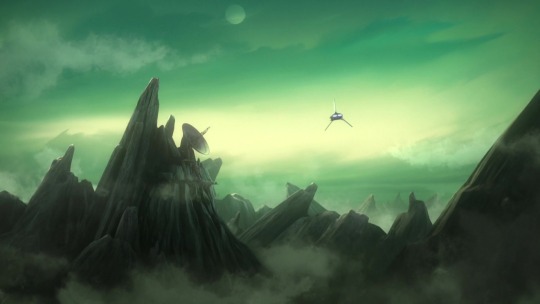
Neat.
Right so the Stormtroopers don't make Chopper... wait at all? While the scanner is thinking? They just let him through the doors while it's still deciding if he's legit or not?

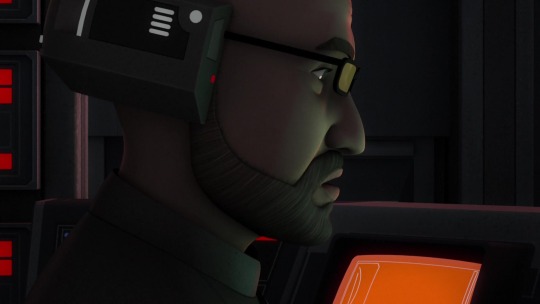
I'm sorry, these guys are just... so bizarre. The one dude with glasses that looks uncannily like Pablo Hidalgo just takes me RIGHT of the immersion.
*whispers* What do they even do?
Also why does the Controller sound way more human than the others????
I have so many questions and even AP and Chopper's bickering can't distract me from them.
Bond Villain Stupidity in not alerting the station.
Though... does anyone actually... work here? We see the other AP droid and no one else inside the facility at all.
The Controller is thinking to capture the base coordinates from Chopper. Not a bad plan but fortunately Hera wipes his memory banks between every mission, because as much as she loves her droid she can't risk compromising the safety of the Rebellion's operations and therefore takes reasonable precautions in case Chopper gets lost, stolen, or captured, Anakin.

Who are you, weird glasses man?
I'm not sure why the Alliance needs the orbital clearance codes for Lothal. They're not exactly planning to sneak in through the blockcade when they make their attack. Unless they planned on using the Quasar carrier or something to get behind the blockade and then release a whole bunch of fighters while in atmosphere?
Like, this wouldn't be an issue if the episode had not established, specifically, "We need these codes for the eventual attack on Lothal." If they had just needed updated codes to get in and out through the blockade since they'd been changed or cycled out that would be one thing but as it is....
*CLUELESS SHRUG*
Yooooooouuu are gonna need to run those numbers again my man, there's no way you had close to any kind of 80% chance of getting near the Rebel base.
Chopper being nice is immediately suspicious.
Controller dude is doing a terrible job impersonating Chopper, which is why this was a dumb plan to begin with.
"We must appease him [AP-5]." Literally the opposite of what Chopper would do, you need to actually study your targets before trying to impersonate them, why are y'all so bad at this?
This is one of those tropes that annoys me, when the impersonator is doing such a bad job of playing the target that it should ping people's suspicions or at least make them ask what the hell is up with them.
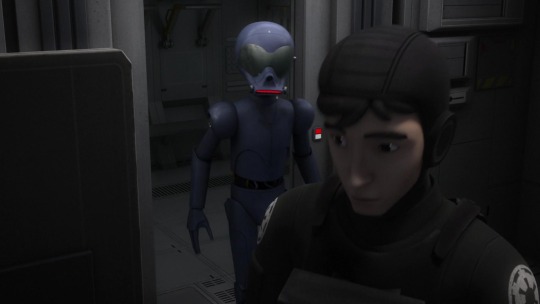
Poor Wedge is such a butt monkey in this episode but it is hilarious.
Rebels said don't be so quick to discount conspiracy theories, send note.

<333333
To AP-5's credit, Ezra and Hera do ping Chopper's behavior as weird.
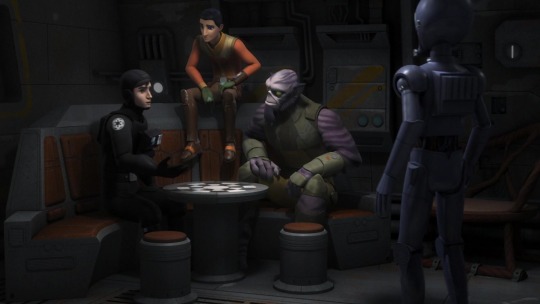
Ezra honey, please sit on the furniture like a normal person lol.
All right, some props in that we figure things are funky much quicker than most characters in this type of scenario.

-squint-
Who's... who's room is that?
*mental map of the ship*
Gotta be Hera's, right? Closest to the cockpit, correct side... Except it doesn't look like the props and assets from Hera's room so I dunno.
*rubs temples* Why do they need a data spike to decode the navicomputer? Chopper never needed to do anything put plug in to access the navicomputer before, this is only to add a ticking clock device isn't it?
Some people questioned why Ezra didn't use his lightsaber, which could have been a plot hole except for one I'm sure Hera would severely disapprove of her ship being chopped up and two... he doesn't have his lightsaber, it's not clipped to his belt anywhere.

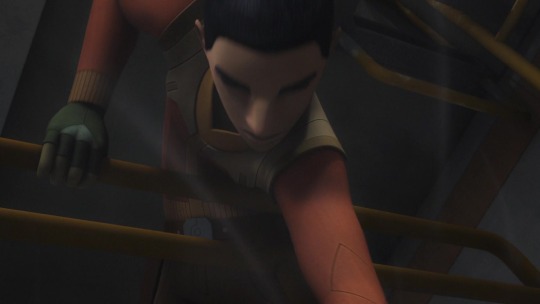
Ezra managing to hang on to Zeb here is kind of impressive, actually.
You can tell Chopper's compromised and trying to find the base from the hold computer? Really?
"We don't have spacesuits." YOU GET 'EM LATER THOUGH, LOLOL.

I'm sorry I cannot take you seriously dude, lol.
Gdgkjhkgshd WAS THAT THE DEJARIK TABLE CHOPPER PICKED UP THOSE BLASTERS FROM? HOW. THERE WERE NO BLASTERS ON THE TABLE WHEN THE GROUP LEFT THE ROOM. WHOSE BLASTERS EVEN ARE THOSE?
*shakes writers* WHY DOES THIS EPISODE MAKE SO SENSE?!

Ooooh Hera mad.

See, Ezra knows.
That's... not even remotely how that works, Hera, but okay,
OKAY.

This genuinely sad moment deserved such a better episode.
The unhinged insanity that is AP-5 almost breaking into a musical number.
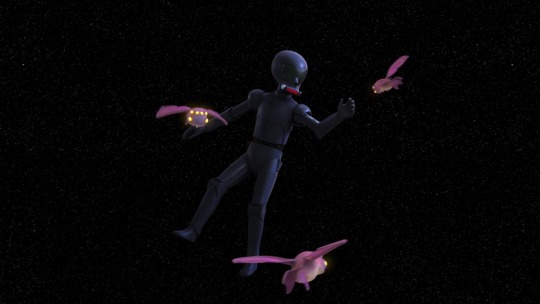
"No no no go away! I was SO happy!" WHY DID THEY STICK THE FUNNIEST LINE IN THIS EPISODE IT'S NOT FAIR LOLOLOL.
Wedge getting caught in the crossfire lol.
This episode is... I don't even know. Nothing about it makes sense, it has moments of genuine hilarity but they're mismatched pieces in a weird patchwork of tropes and plot elements that are disjointed and slapdash and I just--*rubs face over hands*--it's so BIZARRE and it's funny in a way but I can't I just... can't.
Not even trying to superficially tie this into Thrawn's search for the base gives this enough plot relevance, I would... I would not keep this episode. Like, either fold some of this into "Warhead" to make that stronger or axe this entirely and wholecloth replace it with something else. (Maybe another episode of Ezra struggling with his holocron addiction since people were apparently so pressed that that arc was short.)
I think even the show was embarrassed about this one, I remember we would usually get an episode preview in the Rebels Recon and a TV spot before each new episode and with this one they just kind of... skipped ahead to talking about "Twin Suns", ha ha.
Final verdict I guess? I would save the funny bits and try to put them in a different episode but otherwise this episode is kind of a skip.
20 notes
·
View notes
Text
I'm bad at these because I can never answer just the one thing, but sure:
Last song: "Flame" from KATSEYE (the Jentry Chau theme). I don't listen to music super often, to be honest (not that I dislike it, but I have to be in the mood to focus on it. If I need background sound it's usually a podcast or a YT let's play). Part of this playlist.
Last book: The Storm Runner, by J.C. Cervantes (in progress); The Nectar of Immortality, by Roshani Chokshi (completed). Making slow progress with the former (I'm not quite as hooked as I'd like to be), absolutely enjoyed the latter (and the series as a whole)
Last movie: Dungeons and Dragons: Honor Among Thieves (a rewatch with the fam, lovely and severely underrated film, someday I'll write a crossover with the BG3 crew lol). Hoping to finally watch Sonic the Hedgehog 3 this weekend!
Last TV show: I've been flitting around like an indecisive hummingbird lately, so...Spy x Family (watched four eps last night, t'was cute), The Avengers: Earth's Mightiest Heroes (I've watched bits and pieces over the years, but this is my first proper watchthrough), Sakamoto Days (watched the two available eps last night, I had decent fun with it, it's an entertaining premise), DanDaDan (freakin' bizarre show, but I adore it), the Ranma 1/2 reboot (very funny, but the season was way too short), and Arcane (S2 felt a little bit rushed but it's still a fucking masterpiece overall).
(if this question was intended for live action stuff, I have no idea lol, been ages since I watched anything not animated)
Last (5) thing(s) I googled: "apokolips", "miss fortune game", "chromatic aberration", "quasar", and "jason vorhees" (I did not know it was spelled voorhees, YIL)
Favourite colour: blue, red, or black (varies depending on the day)
Sweet/Savoury/Spice: definitely savory, but I don't mind sweet things every now and then. I can handle spice decently well, but don't usually enjoy it.
Relationship status: single (and not particularly looking to/opposed to mingle)
Looking forward to: playing more games, watching more shows, reading more books and comics, writing more fics. Also, Silksong (for the meme, you understand).
Current obsessions: geez, off the top of my head - Godzilla, Sonic the Hedgehog (the series overall, and Shadow the Hedgehog in particular), Baldur's Gate 3, DanDaDan, BotW/TotK, and pretty much anything that's in the Kryptonverse already.
thank you for the tag friend @darkerthanblack-666 🖤
last song: escapist - nightwish
last book: the book of summer by tove jansson
last movie: the new animated lord of the rings movie. hated it
last tv show: ?? hazbin hotel last year i think?
last thing i googled: microsoft excel cheat sheet
favourite colour: black, dusty pink, burgundy 🖤 in general ive been loving soft earthly tones in my clothes
sweet/savoury/spicy: savory and spicy
relationship status: married to aleksi he just doesn't know it yet
looking forward to: my party!!!
current obsessions: blind channel as always, vampires and gothic aesthetics (again. after years) after the nosferatu movie
tagging: @ladysorbus @xyelissax @where-pain-is-so-pretty @blindchandelure @maaninenpyromaani
125 notes
·
View notes
Photo

This is a fictional comic book from Mallory Bash--Mallory's favorite, in fact! Kate Quasar is a cosmic detective. Basically like a Judge (Judge Dredd), but in space.
#mallory bash#kate quasar#illustration#cartoon#comic#web comic#webtoon#comic book#comic book cover#cover art#digital painting#digital illustration#cosmic inquisitor#bizarre comics
2 notes
·
View notes
Photo
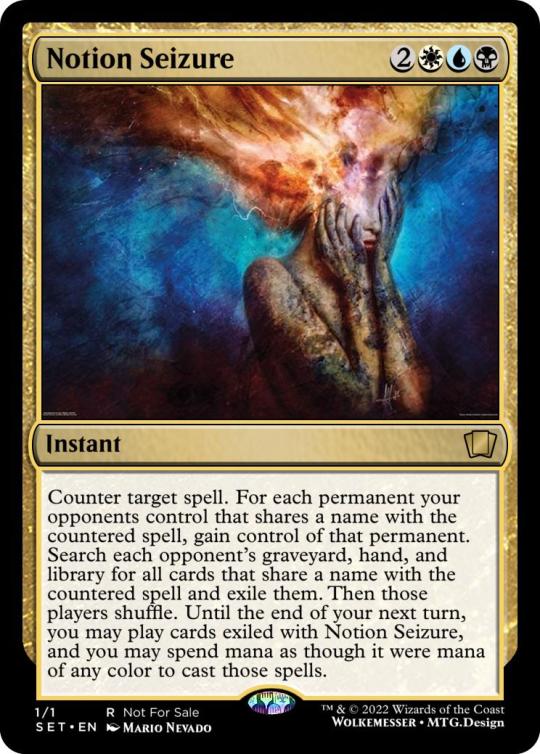


Counter Your Blessings: Winners!!!!
Congrats to this week’s winners!!! There were a lot of really good submissions this week, but these ones really caught my eye and were executed cleanly, both mechanically and flavorfully.
Notion Siezure by @wolkemesser
This was the very first submission I received and, I gotta say, it really raised the bar. I love this. This is gonna be rough to get hit by, but it’s gonna be soooo fun to hit someone with. It might be a mana too cheap maybe? But it’s very reactive and hard to control, so maybe not. If you want to power it down without raising the mana cost, maybe it could exile the permanents to let you cast them rather than gaining control directly? But maybe that’s not necessary. I’m honestly not sure. I just know that I want to play with this card. (And as a minor wording note, you could probably simplify the mind control effect to “gain control of each permanent with the same name as that spell”.)
Quasar by @allie
What a bizarre card! Not bizarre in a bad way, in fact I’d even say in a good way, just. Very bizarre. I quite like it! Seems well balanced all around. None of the modes seem broken, nor does the flexibility this offers. The one change I’d make is to find another mode to cost three, more for aesthetic, melviny reasons than balance ones. It seems odd that all the modes but one cost two mana. Maybe switch white and green, and upgrade the “destroy target artifact or enchantment” to exile?
Sting Operation by @helloijustreadyourpost
This is a pretty solid design mechanically that’s tied up really nice and neat with the flavor. I’m a big fan! The only thing I’d change is to tie the detaining more directly to the countering. Something like “Counter target spell an opponent controls. Detain all creatures that player controls”. This is more just for aesthetic reasons honestly, I think it ties it all together well. As the tiniest possible note, I think I’d unemphasize the “of” in the flavor text.
Runners will be up shortly!
#mtg#magic the gathering#custom magic card#inventors' fair#expensive counterspell contest#winners#commentary
11 notes
·
View notes
Text
It's Time for 'LGB' and 'T' to Go Their Separate Ways
Brad Polumbo
26 Oct 2019
---------------------------------------------------------
The growing rift between increasingly radicalized transgender-rights activists and the lesbian, gay and bisexual (LGB) communities has finally come out into the open. This week, Europe’s biggest LGBT-rights organization, the London-based Stonewall charity, was publicly accused of subordinating LGB rights to the group’s increasingly single-minded goal of replacing sex with gender as a marker of identity. As Helen Joyce recently wrote in Standpoint, “Stonewall went all in for gender self-ID. Its online glossary now describes biological sex as ‘assigned at birth’ (presumably by a midwife with a Hogwarts-style Sorting Hat). ‘Gay’ and ‘lesbian’ now mean same-gender, not same-sex, attraction. ‘Transphobia’ is the ‘fear or dislike of someone based on the fact that they are trans, including the denial/refusal to accept their gender identity.’ At a stroke, anyone who declares themselves exclusively attracted to people of the same sex has become a bigot.”
As a gay man who lives in the United States, I have no direct stake in Britain’s intra-LGBT politics. (“LGB/T” might now be a more apt term.) But I am surprised that it has taken this long for such a formal breach to occur. The same pressures have been building everywhere, and it was only a matter of time before someone acted on them.
After the U.S. Supreme Court legalized gay marriage nationwide in the landmark 2015 decision Obergefell v. Hodges, many believed the fight for gay rights would begin to wind down. Yet that didn’t happen. Instead, the LGBT-advocacy sector simply redirected its available staff, fundraising and rhetoric to other projects. I know this because I saw this happen, both as a university student, gay man and equal-rights advocate.
LGBT flag designed by Daniel Quasar.
In a relatively short period of time, the gay-rights movement fused with more radical campus-based gender and identity-politics movements, to become the compound movement now known as “LGBTQ+”—lesbian, gay, bisexual, transgender, “queer” and more. Even many people within the movement now have trouble keeping up with all the new subcategories contained within that plus sign. One version of the rainbow flag unveiled last year has 11 different colors on it. The creator, Daniel Quasar, identifies as a “queer non-binary demiguy” whose pronouns are “xe/xem/xyr.” None of these bizarre neologisms have any resonance to those of us who joined the gay-rights movement simply to affirm and protect the basic rights of people to be who they are and love who they choose without stigma or legal sanction. We’ve been forced to watch the simple moral logic of non-discrimination be transformed into a self-parodic alphabet soup of invented identities.
Over the last few months, a Democratic presidential debate focused on LGBT issues was highjacked by a rogue transgender woman who shouted slogans about trans rights while the candidates and moderators nodded along robotically. Presidential candidate Joe Biden has called for unisex prisons, a policy that, if implemented, would lead to the rape of female prisoners. Senator Kamala Harris, another Democrat running for president, even came under fire for daring to suggest that pregnancy is a “women’s” issue—since it is now fashionable to highlight the fact that trans men and the “non-binary” also can bear children.
In his recent Netflix special Sticks and Stones, comedian Dave Chappelle nearly got himself canceled for pointing out the growing estrangement between the LGB and trans communities (whom he collectively referred to as “alphabet people”). This being a forbidden topic, it goes without saying that the ultra-woke outlet Vice ran a scathing review of the special, later echoed by other progressive outlets, such as Salon. LGBT activists chided Chappelle for his alleged transphobia on Twitter, despite the fact that viewers themselves gave the show a 99% rating. This is now a typical pattern: Whenever someone runs afoul of gender orthodoxy, the official pundit class has to pretend it’s appalled, a difficult conceit to sustain when sites such as Rotten Tomatoes make popular assessments a matter of public record.
Chappelle used the analogy of a car trip shared by passengers G, L, T and B. The Gs are driving, with the Ls in the passenger seat. The Ts are in the back. “Everyone in the car resents the Ts,” Chappelle says. “The Ts are making the trip take longer.” Trans comedians and activists, who’ve become accustomed to pride of place in the intersectionalist hierarchy, were up in arms. But Chappelle made it abundantly clear that he had no animus toward anyone in the LGBT community: The target of his satire was not any one group, but the increasingly ridiculous conceit that all of these “alphabet people” are happy fellow travelers. LGB rights and T activism have been revealed to be unnatural bedfellows, and it’s inevitable that, as is happening in Britain, they will go their separate ways.
Gays, lesbians and bisexuals all have something obvious in common: same-sex attraction. This is an alternative sexual orientation that, to some extent at least, shapes our experiences and alters our life outcomes. We typically identify with our biological sex—and in fact, sometimes have spent many years feeling trapped by it. To be gay is to understand that sex is set at birth. My sexual attraction, likewise, is based on hard-wired factors beyond my control.
Transgenderism is a separate concept. While homosexuality leads to obvious differences in real-life behavior, transgenderism offers a categorial redefinition of what it means to be a man or a woman. As Joyce describes it, a “gender identity” is a quasi-spiritual concept—almost like a soul—that is “something between an internal essence, knowable only to its possessor, and stereotypically masculine or feminine appearance and behavior.”
Gay rights activists simply want society to accept their different ways of living and loving—since gay men and lesbians pursue romantic interests and build families in ways that are at odds with conventional heterosexual expectations. Followers of radical gender theory, on the other hand, demand that we all reject our basic understanding of biological sex in favor of a recently conceptualized abstract notion of human identity.
Of course, the idea of transgenderism per se isn’t new—nor is the (perfectly valid and just) demand that people with gender dysphoria be treated with decency and respect. But the original form of this demand was based on the far more reasonable idea that gender is a social construct distinct from biological sex. It was not disputed that a transgender woman is a biologically male human who identifies with the social norms traditionally associated with woman. But in recent years, transgender activists have demanded that sex and gender be conflated, and that the very idea of innate biological differences be pushed into the background. At the most absurd extreme, there are now athletes and scholars who seriously suggest that being male offers no competitive physical advantages over being female, a proposition that even small children know to be unhinged.
One of the unsettling elements embedded within this advocacy is the demand that women—lesbians, more specifically—make themselves sexually available to trans women, on the far-fetched theory that gender identity, not sex, is the real source of human attraction. As Jonathan Best notes, Stonewall now has defined “homosexuality” as referring to “someone who has an emotional romantic and/or sexual orientation towards someone of the same gender.”
“Did you see what happened there?” Best writes. “Same-sex attraction has become same-gender attraction. This might seem academic. But take a moment to reflect on what it means in the context of Stonewall’s affirmation of gender identity. Stonewall is asserting that lesbians are attracted to anyone with a female gender identity, whether that person is biologically male or female. This turns gay and lesbian desire into transphobia. I’m a gay man—I’m attracted to male bodies—not people performing male gender roles. And, yes, that means I like male genitalia. (I really like it). Trans activists argue that my sex-focused homosexuality is transphobic. I’ve seen trans activists compare non-trans inclusive gay desire to racism and describe gay sexuality as ‘genital hang-ups.’”
In the United States, the Democrat-controlled House of Representatives has passed the Equality Act, a so-called LGBT rights bill that outlaws discrimination on the basis of sexual orientation and gender identity. That is a noble goal that would seem to be in keeping with America’s larger civil-rights legacy. But the Act explicitly redefines biological sex under federal law according to self-defined gender identity—so it easily could allow for a whole host of adverse consequences. And as we have seen in Canada, where a trans woman tried to leverage human-rights law to force immigrant aestheticians to wax her “female” scrotum and penis, the victims of this movement tend to be women.
Even under current U.S. law, Title VII of the Civil Rights Act serves to outlaw discrimination on the basis of “race, color, religion, sex, or national origin.” Activists are arguing that transgender identity is protected under the law’s reference to “sex,” even though “gender identity” is mentioned nowhere in the law. Trans activists also are demanding government support for policies that subject gender-confused children to potentially sterilizing hormones and other aggressive therapies. Their rights are being sacrificed on the altar of gender self-identification as well.
The redefinition of sex as gender is a step that most people—even the most well-meaning and humane members of society—simply will never accept, no matter what laws activists manage to get passed. And the effort to ram this doctrine down the throats of ordinary people will tarnish any movement that insists on such mantras. So long as self-described “LGBT” activists demand that a male with gender dysphoria is “really” a female, many otherwise accepting people will remain opposed to, or at least skeptical of, the wider movement.
As a right-of-center journalist, I know dozens of young conservatives, particularly women, who are completely open and accepting of their gay and lesbian friends, and supportive of gay rights; but simply won’t accept that a man can be a woman, even if they are forced to give lip service to this mantra as a condition of passing sensitivity-training courses or using social media. Many progressive news outlets were aghast when new polling showed that “young people are growing less tolerant of LGBTQ individuals.” But a closer look into the survey’s methodology revealed that on most questions, they were asked about “LGBTQ people,” not gay people. Support for “equal rights” remained steady, but comfort around “LGBTQ” people has declined. Notably, the survey found that comfort levels around “a same-sex couple holding hands” remain virtually unchanged. Although it’s fashionable to pretend otherwise, it’s the T that’s the issue.
To repeat what I wrote above, transgender people deserve to be treated with dignity and respect. And I have spoken out strongly against anti-trans policies (such as a ban on trans soldiers in the U.S. military). To say that these two causes—LGB and T—should separate isn’t to say that one has value and the other does not. I am simply noting that their goals are at odds. As gay writer Andrew Sullivan recently wrote in New York magazine:
The truth is that many lesbians and gay men are quite attached to the concept of sex as a natural, biological, material thing. And gay men are defined by our attraction to our own biological sex. We are men and attracted to other men. If the concept of a man is deconstructed, so that someone without a penis is a man, then homosexuality itself is deconstructed. Transgender people pose no threat to us, and the vast majority of gay men and lesbians wholeheartedly support protections for transgender people. But transgenderist ideology — including postmodern conceptions of sex and gender — is indeed a threat to homosexuality, because it is a threat to biological sex as a concept.
Canadian writer Sky Gilbert, a gay writer, made a similar point in Quillette, noting that transgender activists increasingly are telling young children who may grow up to be gay or lesbian that their effeminate or butch expression is actually a sign of a transgender soul trapped in the wrong body: “Until the latter decades of the twentieth century, if parents caught their son playing with dolls, they might suspect he was gay. And if he grew up to be an adult with same-sex desire, he would go to a psychiatrist to seek help. Now that we have (spuriously) separated sexuality from gender, a parent who catches his boy playing with dolls will take a trip to a psychiatrist—but this time for different reasons: Little he might be a little she.”
The idea of biological sex is at the core to the gay identity—of my gay identity—and the stereotypical definitions of gender expression that the transgender movement peddles ignores the existence of men and women who happen to express their gender in unorthodox ways without actually being transgender. Most of these people simply grow up to be gay. To demand that these children be instead labeled gender dysphoric is essentially a form of woke conversion therapy. We gays experienced quite enough of that phobic behavior from the socially conservative right. We have no interest in getting force-fed another serving from the progressive left.
5 notes
·
View notes
Text
300 followers special: debunking Arahabaki
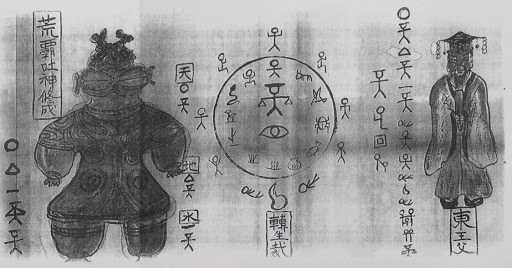
Arahabaki is a mythical figure with a relatively large popculture footprint, mostly thanks to Shin Megami Tensei, but little to no source material to go with it. For this reason, especially in english-speaking spheres, many claims rooted in pseudohistory and hoaxes, such as the image above, circulate uninterrupted. Under the cut, I will attempt to debunk their source. If stories about dogu, piss bottles and improbable journeys to Ecuador interest you, you found the right place.
The claims of Arahabaki's antiquity and in particular associating this obscure deity with dogu – specifically the shakoki dogu - all go back to Tsugaru Soto Sangunshi (I will refer to it as TSS in the rest of this article) and other associated writings, so called ”Wada family documents,” all of them written by a certain Kihachiro Wada. It's a series of forgeries created in the 1970s (with additional works produced through the rest of Wada's life – he passed away in 1999), which in addition to presenting a fictional history of the Tohoku region, centered around a fictional local kingdom, also mention Mayan prophecies, Nostradamus, Mu, and various scientific concepts, usually misunderstood by the author. To my knowledge, TSS is only covered in one english language source, which is horrid and basically unusable - The Sacred Science of Ancient Japan: Lost Chronicles of the Age of the Gods by Avery Morrow, which does present the truth - eg. that it's a forgery - but then the author gets caught up in some sort of Evola-influenced spiritual doctrine which makes him claim that perhaps it's an echo of some "spiritual truth" or something along these lines, which is obviously not a sound argument from the perspective of anyone with even just a passing interest in history. Social sciences are still sciences, not religions. TSS claims shakoki dogu represent an “outlawed” god formerly worshiped by people inhabiting Tohoku, whose name was also their endonym. It doesn't delve deeper into the history of Jomon art, and doesn't acknowledge dogu other than shakoki – considering not all dogu found in the Tohoku region (or even further north) belong to this category, it potentially makes it possible Wada was simply familiar with von Daniken’s confabulations and had no other exposure to jomon art; I have not seen this possibility in any japanese debunking articles, though. It's additionally worth noting here that while the exact purpose of dogu remains unknown up to this day, they're neither a taboo (indeed, many towns use peculiar locally excavated dogu as mascots nowadays, like Ravi from Minami Alps), nor particularly rare – estimatesof the number known today vary between 15000 (National Museum of Japanese History estimate) - 18000 (estimate from this article). The majority are of course not shakoki dogu; the difference between various estimates likely comes from different approach to counting figures only known from fragments.

Wada claimed that he merely discovered TSS, rather than wrote it – according to his account, a case of old documents fell from the ceiling while his house was being renovated in 1948. Supposedly, the discovery – so called “Kansei original” - was compiled between 1789 to 1822, and then copied between 1870 and 1910. Wada later claimed he lost the original, but based on gathered evidence it seems obvious it never existed. Various pages known to researchers, purported to come from the original, the Taisho copy, and writing Wada confirmed to be his own, are written in the same style, and with the same mistakes. Additionally, as a visit made in the house by a debunker at the request of Wada's cousin, who appears to be its owner currently, confirmed it's virtually impossible that a large number of documents could have been stored above the ceiling; it has also been called into question if the house existed before 1950. What the visit did reveal was a large number of plastic bottles containing human urine, left undistrubed since the 1990s. A relatively unsophisticated way to make paper appear older than it is requires soaking it in urine, and this rather offputting find has proven that this was Wada's preferred method of making his writing appear older than it is to onlookers, especially these lacking formal experience with antiquities.

Truth to be told, even without the grand urine discovery, TSS was not difficult to discard as a forgery. As I mentioned above, its particular weakness are bizarre references to scientific concepts and discoveries, revealing a low level of historical awareness of the author – for example, references are made to quasars, continental drift theory and Pluto – discoveries not yet made in the suggested eras; to make it more embarrassing, TSS claims it was based on foreign sources which weren't yet published at the listed dates. It also references natural disasters which never happened, and urban legends and folklore which only developed recently, like the claims about Jesus' grave being located in Aomori prefecture, which only date back to the 1930s (Wada's documents claimed it was a story already known in the Kansei period, in the 1790s...). On top of all of this, a number of purported authentic illustrations were simply traced from contemporary sources:

It's worth noting that TSS wasn't the only fraud Wada was involved in, as we can learn from his wikipedia biography he fraudulently claimed to be a former Imperial Palace escort officer before embarking on his adventure with crafting false chronicles soaked in urine. Tragically, TSS found supporters not only among the expected crowd of various wannabe occultists, frauds and naive teenagers, but also among a number of genuine historians, most notably Takehiko Furuta. It would appear that he became interested in it in hopes of finding support for his theories about Japan originally having more than one ruling family, but with time he fully embraced it, and actively advocated the bizarre visions it contained. A particularly outlandish claim of his was insisting that Meiji era educator and political activist Fukuzawa Yukichi quoted TSS in his work (the quote in mention appears to be a paraphrase from american declaration of independence). It's worth noting that while Furuta seemingly was a genuinely accomplished scholar of Shinran doctrine, supporting TSS was far from his only adventure with pseudohistory. He was also a staunch believer in the long discredited claims about links between japanese Jomon culture and the Valvidia culture of Ecuador, claiming that various references to fantastical lands lying between China and Japan or beyond Japan prove that the Japanese reached America in ancient times (you can torment yourself with one of such articles here). This theory was briefly advocated by a number of American scholars before him, but obviously has no support today. It's nothing but a new take on XVIIIth century French claims about present day British Columbia being the Fusang described in some Chinese texts. Sometimes strange lands and creatures at the edge of the map are nothing more but fantasy. Furuta's particularly shameful contribution to TSS discourse was declaring that undermining its authenticity is rooted in historical prejudice against the inhabitants of Tohoku and Hokkaido. Personally I'm under the impression that discarding an entire region's real, very complex history in favor of fanciful hoaxes is much more likely to be rooted in such prejudice. The claim Arahabaki was an Ainu kamuy, common online, appears to come from a similar place – I will not examine it here, but I find attempts to shield forgeries from criticism by attaching them to poorly documented and historically suppressed beliefs of historically persecuted groups to be even more disgusting than regular fraud of this sort. What Arahabaki actually is? This is difficult for me to tell for sure, but certainly nothing out of ordinary - not a dogu, and not the main figure of some lost fabulous country. There is a number of mundane temples enshrining Arahabaki, for example here. This article also mentions a number of mundane locations enshrining Arahabaki today; curiously, many of them are located outside Tohoku. A number of theories exist, linking Arahabaki to the usual suspects: religious beliefs of the Emishi people, who originally inhabited Tohoku, and may or may not be one and the same as ancestors of present day Ainu; snake worship; ironworking traditions; marebito beliefs; gods enshrined in freshly established fortresses... Whatever the truth is, it will inevitably turn out to be more interesting than hoaxes, as study of history generally proves.
344 notes
·
View notes
Text
WHAT ARE QUASARS??
Blog #25 Wednesday, October 7th, 2020
Welcome back,
Astronomers first knew they had a mystery on their hands in the 1960s when they turned the first radio telescopes to the sky.
They detected the radio waves streaming off the Sun, the Milky Way and a few stars, but they also turned up bizarre objects they couldn’t explain. These objects were small and incredibly bright.
They named them quasi-stellar-objects or “quasars”, and then began to argue about what might be causing them.

Shining so brightly that they eclipse the ancient galaxies that contain them quasars are distant objects powered by black holes a billion times as massive as our sun. These powerful dynamos have fascinated astronomers since their discovery half a century ago. The first was found to be moving away at more than a third the speed of light.
But was it really?
Maybe we were seeing the distortion of gravity from a black hole, or could it be the white hole end of a wormhole. And If it was that fast, then it was really, really far… 4 billion light years away. And it generating as much energy as an entire galaxy with a hundred billion stars.
What could do this?

Here’s where Astronomers got creative. Maybe quasars weren’t really that bright, and it was our understanding of the size and expansion of the Universe that was wrong. Or maybe we were seeing the results of a civilization, who had harnessed all stars in their galaxy into some kind of energy source.
Then in the 1980s, astronomers started to agree on the active galaxy theory as the source of quasars. That, in fact, several different kinds of objects: quasars, blazars and radio galaxies were all the same thing, just seen from different angles.

And that some mechanism was causing galaxies to blast out jets of radiation from their cores. We now know that all galaxies have supermassive black holes at their centers; some billions of times the mass of the Sun. When material gets too close, it forms an accretion disk around the black hole.
It heats up to millions of degrees, blasting out an enormous amount of radiation.
The magnetic environment around the black hole forms twin jets of material which flow out into space for millions of light-years. This is an AGN, an active galactic nucleus.

The properties of an active galaxy are determined by the black hole's mass, the rate of accretion onto the black hole, whether or not it has a powerful jet, and the angle at which we view the galaxy. Radio galaxies, quasars, and blazars are AGN with strong jets that can travel outward into large regions of intergalactic space.

Some of the apparent differences between types of AGN are due to our having different orientations with respect to the disk. With blazars and quasars, we are looking down the jet.
Active galaxies are intensely studied at all wavelengths. Since they can change their behavior on short timescales, it is useful to study them simultaneously at all energies. X-ray and gamma-ray observations have proven to be important parts of this multi wavelength approach since many high-energy quasars emit a large fraction of their power at such energies.

The X-rays in AGN originate from very near the black hole, so X-ray studies can provide scientists with unique insights into the physical processes occurring in the central engine. In addition, gamma-ray observations alone can provide valuable information on the nature of particle acceleration in the quasar jet and clues as to how the particles interact with their surroundings.
COMING UP!!
(Saturday, October 10th, 2020)
“WHAT ARE SUNSPOTS??
#astronomy#astrophysics#astro notes#astrophotography#astronomylover#the sun#sunspot#quasar#universe#alternate universe#outer space#spacecraft#space#my blog#come to the dark side#moon#mars#mercury black#venus#earth#jupitar#saturn#dark energy#dark matter#strange matter
30 notes
·
View notes
Text
it's always bizarre to me to come back here every 6 months or so and see that I have several years old posts still occasionally making rounds and gaining notes. especially when one is a holiday joke based on a meme that had its 45 seconds of fame in what i'm reasonably sure was 2014. And of course the river of notes from the-quasar-hero's haunted house post.
6 notes
·
View notes
Text
What are active galactic nuclei?
The structure of an active galactic nucleus
Active galactic nuclei and star formation
Focus: black hole assembly line
Planets around a black hole? Calculations show possibility of bizarre worlds
Star ejected from Milky Way’s “heart of darkness” reaches mindblowing speed
Simulations show black holes have surprisingly intimate relationship with host galaxies
Supermassive black holes stop galaxies from making new stars
A weakened black hole allows its galaxy to awaken
“Cold quasar” discovery sheds light on galactic death
Six galaxies undergoing sudden, dramatic transitions
The Milky Way's supermassive black hole erupted with a violent flare just a few million years ago
Milky Way’s central black hole flares as it feasts
sorry to drop like an hour of reading on y’all this morning but a) as recently as 1970 we thought galactic nuclei were full of nothing but dust and b) not to be sensationalist i’m having a hard time figuring out how likely it is that the black hole at the center of our galaxy is about to become very suddenly active
so, to try to construct a (possibly incorrect) story out of this:
there is a strong correlation between galaxy size vs nucleus size, and star formation. star formation in small galaxies with large nuclei is quickly quenched (quickly on cosmic timescales) (7, 8). the opposite is also true, and small nuclei in large galaxies have been observed to cool the intergalactic medium, jumpstarting star formation to incredible rates (9)
star formation doesn’t necessarily end after quenching, and there seem to be other processes involved (10)
regardless of their size, nuclei can be active or dormant, and the relationship to star formation seems to persist throughout activity and dormancy. although we don’t know at this point, it would appear activity is somewhat arbitrary -- one article (12) describes it "like volcanoes”
the transition from dormant to active can be quick on human timescales (11)
the accretion disk serves as a funnel where massive objects congregate (4), it may house planets and stars compressed out of dust by its extreme gravity (5), and it can either consume these or eject them at high speeds (6, which was probably a binary star system that got a little of both). some of LIGO’s detections may have been collisions of stellar mass black holes orbiting a nucleus (4). whether the accretion disk is capable of creating its own new stellar or intermediate mass black holes (i.e. by direct collapse from dust, or by collapsing or colliding stars that were formed there, not by merger of preexisting holes or stars) is unclear
the milky way is believed to have been active 3.5my ago (12). it seems to have been dormant ever since, but it flared at least 3 times this year, most recently on may 13th (13)
none of the links suggest this, but it seems obvious to me that, for the transition from dormant to active nucleus, one grain of rice can tip the scale. it’s a precarious, unstable, chaotic system, and one planet or star falling in at just the right time, when some of the other material in the accretion disk is nearby enough to be consumed by the size increase from the first infalling object, could be sufficient to start a cascading effect
another thing that has been really interesting for me to ponder is the way time dilation must affect star and planetary formation. like, the star that got launched out of the galaxy must have become exceptionally old relative to us in a comparatively short time relative to it... right?
still absolutely baffled as to what could have caused hoag’s object. a really big cascade? wouldn’t it have to be bigger than a blazar? (or just rarer and weirder?) is it possible there could be an event so catastrophic it just... completely obliterates a supermassive black hole, or drastically reduces its size, or something? idk
10 notes
·
View notes
Text
Earth’s Mightiest Retrospective Ep 32: “Michael Korvac”

(Directed by Boyd Kirkland, Written by Dan Abnett and Andy Lanning, Original Airdate: May 6, 2012)
This is one of the episodes of Avengers: Earth’s Mightiest Heroes where the fact the series completed its run before the MCU’s Phase II began gets to stand out a little bit more than usual. I’ll get into the reasons why a little later when discussing this episode’s guest stars, the Guardians of the Galaxy, and how they’re presented in depth. The tone here feels more in line with the Bronze Age works of Jim Starlin than the usual superhero action of the series. Fitting since Starlin co-created its title character, Michael Korvac. He’s introduced to us when he teleports into the middle of Central Park, leaving a crater, jittery and ranting about how “they’re coming for me” while pointing to space.
Korvac’s arrival coincides with Wasp still processing how Hank left the team and what that could mean for their relationship. She regrets letting her anger get the better of her last time and wants to talk to him again. The police bring Korvac to Avengers Mansion and ask if they can investigate the legitimacy of the raving man’s claims about being abducted by aliens and experimented on. Jan calls in the rest of the Avengers and Jane Foster to see what’s going on with the clearly traumatized man.
Black Panther and Iron Man research the energy coming off him, though Hulk’s amusingly the one to figure it out as Tony’s explaining it to him and says he probably wouldn’t understand. The Green Goliath states plainly, “It’s a form of cosmic radiation.” In the meantime, Janet’s using Korvac as an opportunity to process what she’s going through in her relationship by reaching out to a person he keeps talking about in his rants, his love Corrina. When the two are reunited for the first time in two years, a different side of Korvac surfaces. Rage flares up in his voice and he tells Corrina he’ll protect them from the people coming after him.
The Guardians of the Galaxy burst into the mansion and approach the Avengers in a tense standoff. Most of the Guardians screen time this episode gets spent in a misunderstanding fight with the Avengers, since it takes a while for their translators to adjust to Earth. This version of the Guardians, consisting of Star Lord, Phyla-Vell (aka Quasar), Rocket Raccoon, Groot, and Adam Warlock, are presented more seriously than audiences are used to now. It’s a tone and presentation in keeping with the 2008 revamp of the team by Dan Abnett and Andy Lanning, who also wrote this episode of Earth’s Mightiest Heroes. The most joking done with this team is a single comment from Hawkeye about fighting a raccoon and a tree. It may also be a byproduct of how this episode isn’t about them, since they don’t end up getting that much characterization by the end as another side-effect of them not being able to talk to our regular heroes for most of the episode. The Guardians’ purpose here is to be the ones pursuing Korvac, revealed as a cosmic-level threat when he takes all the heroes down.
The cosmic energy within Michael starts flaring up and he takes out all the gathered heroes in a single blast. While they’re knocked out and sent to the mental dimension of the Soul World, the Guardians finally explain Korvac’s deal. The aliens that captured and experimented on him were the Kree, trying to unlock something within humanity’s DNA. Their success lead to unlocking a level of power within the now mad Korvac that destroyed their ship and any subsequent space stations or planets he’d come across. The Guardians say their plan was to use Adam Warlock’s Soul Gem to incapacitate Korvac by taking him to the Soul World.
Now they have a planet-destroying mad man on their hands and he’s busy fighting Ms. Marvel in Central Park. The fight continues to escalate as the Avengers and Guardians can’t find an opening for Warlock to make his move. Corrina sees this and through tears tells Korvac she can’t believe the monster he’s become. His shock at her statement causes him to teleport himself “somewhere not in this dimension” according to Warlock. The episode ends on the Avengers thinking about how the bizarre and terrifying possibilities presented by someone like Korvac being out in the cosmos. Star Lord effectively replying that this encounter was only scratching the surface of what’s out there.
Like I said at the top of this recap, the trauma Michael Korvac went through, what it turned him into and the ultimate tragedy at the end of the episode, losing the one thing he was trying to get back, are all in line with the wonderful, bizarre nature of Marvel’s cosmic comics at their best. The guest spot for the Guardians gave an opportunity for the usual superhero action in-between the sci-fi portions of the story.
One final thing worth noting is that this episode was dedicated to one of the series’ directors, Boyd Kirkland, who passed away after the series completed production. While there’s still more episode’s he directed to come later, the tribute title screen at the end of this one was touching.
Next time, Nick Fury returns to investigate the secret invasion of Earth.
If you like what you’ve read here, please like/reblog or share elsewhere online, follow me on Twitter (@WC_WIT), and consider throwing some support my way at either Ko-Fi.com or Patreon.com at the extension “/witswriting”
#Avengers#Avengers: Earth's Mightiest Heroes#Earth's Mightiest Retrospective#Wit's Writing#TV Review#Guardians of the Galaxy#Marvel Comics#Marvel#superhero tv#superhero animation#animation#comics
4 notes
·
View notes
Photo

Star-Swallowing Black Holes Reveal Secrets in Exotic Light Shows
Black holes occasionally reveal themselves when passing stars get ripped apart by their gravity. These tidal disruption events have created a new way for astronomers to map the hidden cosmos.
Black holes, befitting their name and general vibe, are hard to find and harder to study. You can eavesdrop on small ones from the gravitational waves that echo through space when they collide — but that technique is new, and still rare. You can produce laborious maps of stars flitting around the black hole at the center of the Milky Way or nearby galaxies. Or you can watch them gulp down gas clouds, which emit radiation as they fall.
Now researchers have a new option. They’ve begun corralling ultrabright flashes called tidal disruption events (TDEs), which occur when a large black hole seizes a passing star, shreds it in two and devours much of it with the appetite of a bear snagging a salmon. “To me, it’s sort of like science fiction,” said Enrico Ramirez-Ruiz, an astrophysicist at University of California, Santa Cruz, and the Niels Bohr Institute.
During the past few years, though, the study of TDEs has transformed from science fiction to a sleepy cottage industry, and now into something more like a bustling tech startup.
Automated wide-field telescopes that can pan across thousands of galaxies each night have uncovered about two dozen TDEs. Included in these discoveries are some bizarre and long-sought members of the TDE zoo. In June, a study in the journal Nature Astronomy described an outburst of X-ray light in a cluster of faraway stars that astronomers interpreted as a midsized black hole swallowing a star. That same month, another group announced in Science that they had discovered what may be brightest ever TDE, one that illuminated faint gas at the heart of a pair of merging galaxies.
These discoveries have taken place as our understanding of what’s really happening during a TDE comes into sharper focus. At the end of May, a group of astrophysicists proposed a new theoretical model for how TDEs work. The model can explain why different TDEs can appear to behave differently, even though the underlying physics is presumably the same.
Astronomers hope that decoding these exotic light shows will let them conduct a black hole census. Tidal disruptions expose the masses, spins and sheer numbers of black holes in the universe, the vast majority of which would be otherwise invisible. Theorists are hungry, for example, to see if TDEs might unveil any intermediate-mass black holes with weights between the two known black hole classes: star-size black holes that weigh a few times more than the sun, and the million- and billion-solar-mass behemoths that haunt the cores of galaxies. The Nature Astronomy paper claims they may already have.
Researchers have also started to use TDEs to probe the fundamental physics of black holes. They can be used to test whether black holes always have event horizons — curtains beyond which nothing can return — as Einstein’s theory of general relativity predicts.
Meanwhile, many more observations are on the way. The rate of new TDEs, now about one or two per year, could jump up by an order of magnitude even by the end of this year because of the Zwicky Transient Facility, which started scanning the sky over California’s Palomar Observatory in March. And with the addition of planned observatories, it may increase perhaps another order of magnitude in the years to come.
“The field has really blossomed,” said Suvi Gezari at the University of Maryland, one of the few stubborn pioneers who staked their careers on TDEs during leaner years. She now leads the Zwicky Transient Facility’s TDE-hunting team, which has already snagged unpublished candidates in its opening months, she said. “Now people are really digging in.”
Searching for Star-Taffy
In 1975, the British physicist Jack Hills first dreamed up a black-hole-eats-star scenario as a way to explain what powers quasars — superbright points of light from the distant universe. (Quasars are now known to be supermassive black holes feeding on surrounding gas, not stars.) But in 1988, the British cosmologist Martin Rees realized that black holes snacking on a star would exhibit a sharp flare, not a steady glow. Looking for such flares could let astronomers find and study the black holes themselves, he argued.
Nothing that fit the bill turned up until the late 1990s. That’s when Stefanie Komossa, at the time a graduate student at the Max Planck Institute for Extraterrestrial Physics in Garching, Germany, found massive X-ray flares from the centers of distant galaxies that brightened and dimmed according to the Rees predictions.
The astronomical community responded to these discoveries — based on just a few data points — with caution. Then in the mid-2000s, Gezari, then beginning a postdoc at the California Institute of Technology, searched for and discovered her own handful of TDE candidates. She looked for flashes of ultraviolet light, not X-rays as Komossa had. “In the old days,” Gezari said, “I was just trying to convince people that any of our discoveries were actually due to a tidal disruption.”
Soon, though, she had something to sway even the doubters. In 2010, Gezari discovered an especially clear flare, rising and falling as modelers predicted. She published it in Nature in 2012, catching other astronomers’ attention. In the years since, large surveys in optical light, sifting through the sky for changes in brightness, have taken over the hunt. And like Komossa’s and Gezari’s TDEs, which had both been fished out of missions designed to look for other things, the newest batch showed up as bycatch. “It was, oh, why didn’t we think about looking for these?” said Christopher Kochanek, an astrophysicist at Ohio State University who works on a project designed to search for supernovas.
Now, with a growing number of TDEs in hand, astrophysicists are within arm’s reach of Rees’s original goal: pinpointing and studying gargantuan black holes. But they still need to learn to interpret these events, divining their basic physics. Unexpectedly, the known TDEs fall into separate classes. Some seem to emit mostly ultraviolet and optical light, as if from gas heated to tens of thousands of degrees. Others glow fiercely with X-rays, suggesting temperatures an order of magnitude higher. Yet presumably they all have the same basic physical root.
To be disrupted, an unlucky star must venture close enough to a black hole that gravitational tides exceed the internal gravity that binds the star together. In other words, the difference in the black hole’s gravitational pull on the near and far sides of the star, along with the inertial pull as the star swings around the black hole, stretches the star out into a stream. “Basically it spaghettifies,” said James Guillochon, an astrophysicist at the Harvard-Smithsonian Center for Astrophysics.
The outer half of the star escapes away into space. But the inner half — that dense stream of star-taffy — swirls into the black hole, heating up and releasing huge sums of energy that radiate across the universe.
With this general mechanism understood, researchers had trouble understanding why individual TDEs can look so distinct. One longstanding idea appeals to different phases of the star-eating process. As the star flesh gets initially torn away and stretched into a stream, it might ricochet around the black hole and slam into its own tail. This process might heat the tail up to ultraviolet-producing temperatures— but not hotter. Then later — after a few months or a year — the star would settle into an accretion disk, a fat bagel of spinning gas that theories predict should be hot enough to emit X-rays.
But there’s another option, argued a team led by Jane Lixin Dai at the Niels Bohr Institute and including Ramirez-Ruiz in May. According to their simulations, which include the effects of general relativity, the two kinds of TDEs might just be the same thing seen at different angles. If astronomers are viewing a bagel-like accretion disk from the top, they can see X-rays from the hot inner material swirling right down the drain. When the accretion disk is edge-on, though, colder gas stands in the way. This gas catches X-rays and reemits them as ultraviolet light.
Ultimately, theorists hope to read each event as a variation on the same core theme — and then do deeper science. “Maybe we’ll learn something fundamental about accretion,” Kochanek said. Or maybe “every one will be sufficiently idiosyncratic that it will be like worrying about the shape of a cloud.”
Testing Einstein
The newly discovered TDEs are also helping astronomers to understand supermassive, galaxy-ruling black holes. Only about 10 percent of these giants emit radiation as they feed on surrounding gas, leaving the other 90 percent of them invisible.
TDEs change that. Komossa, an astronomer at the Max Planck Institute for Radio Astronomy in Bonn, hopes to find more binary supermassive black holes: black holes forced to cohabitate after their own galaxies collided, which future space-based gravitational wave experiments will also search for. As a star drains into one black hole, the presence of another supermassive maw nearby would tug at the stream of matter falling in. Instead of a smooth dimming, the TDE would exhibit dips and rises.
Other teams want to test a fundamental, eerie correlation. Somehow the masses of central black holes and their host galaxies seem to increase in tandem. “The mass of the black hole knows about the mass of the galaxy, which is kind of mesmerizing,” Ramirez-Ruiz said. TDEs, plumbing black hole masses in an independent sample of galaxies, could either strengthen or weaken this relationship.
TDEs can also reveal an oxymoronic population: the shrimpiest massive black holes around. While the very biggest known black holes can weigh 10 billion times the sun, and galaxies like the Milky Way host specimens that tip the scales at millions of solar masses, it isn’t clear whether smaller dwarf galaxies are ruled by proportionally pipsqueak versions, in the hundreds of thousands of solar masses or below.
Spotting TDEs from these intermediate mass black holes would settle the question, helping astronomers understand how giant black holes form in the first place. The June paper in Nature Astronomy claims to have found such an intermediate object, one weighing a few tens of thousands of solar masses. That event appeared in 2003, peaked in 2006 and then declined for the following decade. Instead of happening at the center of a galaxy, the X-ray flare occurred in a star cluster, a place where intermediate-mass black holes could coalesce from the mergers of stars. But a single event does not a population make. “We need to find more similar events, to confirm our result,” said Dacheng Lin, an astrophysicist at the University of New Hampshire who led the study.
Then come still deeper goals. TDEs are also starting to test general relativity’s picture of black holes, probing for places where the theory might break.
For example, as a black hole increases in mass, its predicted event horizon creeps steadily outward. But the radius at which the black hole’s tides can crack open a star increases more slowly. At a theoretical limit called the Hills mass, about 100 million times the mass of the sun, a black hole’s star-tearing radius exactly matches its own border. That should put a mass cap on TDEs. “Below that, you can tear something apart. Above that, stars get swallowed hole,” said Nicholas Stone, a theoretical astrophysicist at Columbia University.
So far, the data matches this idea. The rise and fall of known TDEs — already as reliable at weighing supermassive black holes as other techniques — show they all happened around black holes that weigh less than the Hills mass, suggesting that heavier objects likely do have the event horizons that relativity predicts.
But Stone and colleagues are eager to exploit an additional wrinkle. A spinning black hole that weighs 10 times above the Hills mass can still swallow stars. Eventually, after discovering more TDEs, astronomers can watch how the rate of events fades off at high mass, which should help them understand the fastest black hole spins, Stone said.
That might put relativity’s idea of event horizons right back in the crosshairs. A rotating black hole has a theoretical maximum speed, and any black holes seen spinning faster would violate the idea that a black hole has a firm outer boundary.
Thankfully, the observational grist needed to test these various ideas is already on its way. In a dramatic reversal of the field’s beginnings, the new Zwicky Transient Facility is now turning up too many candidates for comfort, Gezari said. She’s starting to strain her resources, trying to get enough telescope time for follow-up observations on each worthy target.
The next leaps come soon. A long-delayed joint German-Russian mission called eRosita, if it goes up in 2019 as planned, should spot hundreds or thousands of TDEs as X-ray flashes. So should the Einstein Probe, a Chinese mission that Komossa collaborates on, scheduled to launch in 2022. And then there’s the Large Synoptic Survey Telescope, currently being built in Chile and scheduled to start scanning the sky in 2022, which should catch its own hundreds or thousands of TDEs among whatever else goes bump in the night.
For Ramirez-Ruiz, this growth since the field’s humble beginnings is a natural consequence of modern “celestial cinematography” — telescopes that shoot night-by-night time-lapse video across the entire sky. TDEs only happen about once every 10,000 years in a given galaxy, when an unlucky star wanders close enough to a black hole. But now that we monitor enough galaxies at once, he said, “the field actually has exploded.”
139 notes
·
View notes
Text
Bizarre, Randomly Generated Stories Involving a Made-up Generation of My Little Pony #30
-INDEX-
Cinque: (excitedly looking at her quasar cutie mark) Okay, guys! Today's the day. I'm finally going to live in accordance with my cutie mark and become a quasar!
Mimio: (confused) Wait, what does that even mean?
Nyx: (sarcastic) Oh, of course, it means she's going to become a giant, exploding star and destroy everything in her path.
Phaedra: (alarmed) That sounds dangerous. Maybe we should try to talk her out of it.
Iris: (intrigued) Or maybe we should see where this goes. I'm curious to see how she plans on becoming a quasar.
Clover: (giggling) I don't know what's going on, but I'm excited to be a part of it!
Cinque: (determined) Okay, first things first. I need to start absorbing a massive amount of gas and dust.
Mimio: (incredulous) You want to become a cosmic dust bunny?
Nyx: (exasperated) That's not how becoming a quasar works, Cinque. You need to undergo a massive gravitational collapse.
Phaedra: (concerned) I don't think we should encourage her to do something so dangerous.
Iris: (smiling) Maybe we can help her find a safer way to become a quasar. How about we use some magic to simulate a gravitational collapse?
Clover: (enthusiastic) Ooh, can we use my spaceship to create a black hole?
Cinque: (nodding) Yes, that's perfect! Let's do it!
Mimio: (still confused) I still don't understand what's happening.
Nyx: (shaking her head) I don't think anyone does, Mimio.
Phaedra: (determined) Let's just hope this doesn't end in disaster.
The group proceeds to use Clover's spaceship to create a black hole, while Phaedra and Iris cast magic to simulate a gravitational collapse. Cinque excitedly jumps into the center, but quickly realizes it's not as glamorous as she thought.
Cinque: (coughing) This is not what I expected. I'm getting pulled apart!
Mimio: (yelling) We have to save her!
Nyx: (frustrated) I knew this was a bad idea.
Phaedra and Iris manage to pull Cinque out of the black hole, but she's now covered in cosmic dust and debris.
Cinque: (coughing) Well, that was a disaster.
Mimio: (laughing) At least you got to live in accordance with your cutie mark!
Nyx: (rolling her eyes) I can't believe we just risked our lives for this.
Phaedra: (smiling) At least we had each other to help out.
Iris: (mystified) And we got to see a pony covered in cosmic dust. That's pretty cool.
Clover: (giggling) And we got to use my spaceship!
Cinque: (grinning) Yeah, that was pretty cool. But maybe next time, I'll just stick to delivering packages.
The group laughs and continues on with their daily lives, knowing that their adventures and interactions will always be a little bizarre and hilarious.
0 notes
Text
Excerpt: Regrets, None by Dolly Thakore
Excerpt: Regrets, None by Dolly Thakore

In July 1979, Rani Dube passed through Bombay. She’d brought Richard Attenborough with her. Richard’s long-cherished dream project, Gandhi, was close to realization. Rani was the co-producer, and she had brokered a meeting between Richard and Indira Gandhi. Mrs Gandhi had given the project her blessing and introduced the two of them to the National Film Development Corporation of India (NFDC)…

375pp, ₹599; HarperCollins
On the 25th of July, Rani brought Richard over to my apartment at around 3 in the afternoon. I was breastfeeding Quasar. We chatted for a while. The walls of our home, as ever, were covered with photographs from plays Alyque had directed. Talk turned to the theatre, to the BBC, to children and life. At half five, I rang Alyque to say, “Ahem, Richard Attenborough is here, and would you come home and we can all have dinner, because, you know, Richard Attenborough?”
I remember we went to Copper Chimney and had Kakori kebabs. But the moment Alyque walked in through the door, Richard turned to me and said, “That’s my Jinnah.”
Two days later, he rang me up.
“Dolly, it’s Richard,” he began. “We’re starting work on Gandhi, as you know. And I was wondering if you’d like to be the casting director?”
It was on the strength of the photographs and the long chat we had that day, about my years in the theatre and my work as a model coordinator and as a host. But mostly, I suspect, it was just a hunch.
I jumped at it. Although no one I knew really knew what ‘casting’ entailed. So, it was just like every other job I ever had.
By November of 1979, Quasar and I moved to the Ashoka Hotel in Delhi. We lived there for the next six months. I was casting director for Gandhi, but I was also the unit publicist and PR liaison.
Richard had already decided on his Gandhi: Ben Kingsley. He was going to cast all the white parts from Britain (and in the case of Martin Sheen and Candice Bergen, the US). I had to find all the Indian actors.
I also worked as a theatre critic at the time, and I watched almost every play on the boards, across the city. I spotted Rohini Hattangadi and called Richard in Delhi.
“There’s a young actress I want you to see,” I said.
“Kasturba?” he asked.
“Kasturba,” I agreed.
Richard was leaving Delhi for London that night. But he would stop in Bombay if he could meet this actress. Would I be able to take a room at the Airport Centaur? He’d nip out, see her and then go back across the street for his flight to London. International flights operated from the same terminal.
Rohini had a show that night. It was past 11.30 before she made it to the Centaur. Richard and I were sitting on the couch, and the moment Rohini walked in through the door, he clutched my thigh.
“This is it, Doll!” he whispered.
Richard had seen something intangible – a quality, an essence. He had a hunch about Rohini. She’d fit into his vision and further it. He could see her on screen. That was what casting was about. That was what one half of filmmaking was.
…”If she can lose about eleven kilos, that’s my Kasturba.”
This, then, was the other half of filmmaking: the journey from casting to the shoot. I rang Rohini the next day. Together, we went to see a Dr Vishnu Khakkar at Kemp’s Corner. He was a dietician…He examined Rohini, heard the brief and then told her that she could eat two chapattis and a bowl of dal for lunch and dinner, and nothing in between. And she had to walk for an hour and a half every day.
Rohini lived in Wadala at the time. Right or wrong, I was convinced that she might follow the dal-roti diet but, left to her own devices, there was no way she was going to take a walk every day. So she’d come to mine, we’d go to Vishnu’s office and lock ourselves into the second room. I’d sit in the chair and she’d walk around the table for an hour and a half. We did this every day for three weeks. She lost five kilos, and I called Richard with a progress report.
“Send her,” he said.
The delegation to London comprised Rohini, Smita Patil, Bhakti Barve and Naseeruddin Shah.
Smita Patil was very much the trendy pick. She was quite a big star by then. She was critically acclaimed and shared, in particular, a wonderful creative relationship with Shyam Benegal. But she wasn’t right for the role. She was too sultry, too aware, had too much spark for that version of that story. It would’ve been bad casting.
My pick – so much water under the bridge now – was actually Bhakti Barve. She was a fine actress. And I felt that she looked like Kasturba. That was enough to seal the deal in my mind.
Naseer’s trip was a political move. He’d made it clear that he was only interested in playing Gandhi. And Richard was set on Ben. But Naseer was a star, a name in the Bombay film industry, and Richard wanted to pitch a host of other parts to him – Nehru, in particular. Which shows how well he knew Naseer. Because that was never going to happen.
Money wasn’t a problem. We put this group of actors on a flight to London to shoot some tests. In fact Gandhi, as my first film, was a bit of a ruinous experience. The producers allowed – “empowered”, I think, is the right word – me to take decisions and paid for them without asking any questions. In other words, they trusted me to do the job they’d hired me to do. They delegated and left it at that; if I screwed up, that was completely my responsibility. No other job has come close.
Richard said ‘no’ to Naseer playing Gandhi. Naseer, in turn, said ‘no’ to Nehru. He wasn’t part of the film which – to this day – feels odd, given that I cast 498 Indian actors. A lot of people remember him being in the film! They’ve ghosted him in, because it feels logical that he would’ve been there. Naseer would have to wait about two decades to play Gandhi in Feroze Khan’s stage production.
Richard called from London to say that Rohini was his Kasturba. He loved her simplicity and naivety – things that are difficult to fake on screen.
The next step was to better her English. I got Kusum Haider to be her teacher in Delhi. I suppose that would be her ‘dialect coach’ in this day and age. Rohini was a model pupil. She maintained her diet and her exercise routine, and she was serious about her English lessons and the spinning class she took with Ben.
Wait. What I mean is that both Rohini and Ben learnt how to weave cotton. They weren’t on exercise bikes, peddling madly.
One of the major criticisms at the time was that Ben Kingsley was too ‘muscular’ to play Gandhi. Ben did all he could to remedy that. He was on a strict diet, and he did a lot of yoga. When he arrived in India, we removed all the furniture from his hotel room so he had to sit and sleep on the floor. The walls were covered with pictures of the Mahatma.
The backlash to the casting decision was inevitable. We were always going to have to confront the question: How could a foreigner play Gandhi? Bizarrely, the makers of ‘parallel cinema’ were the only ones who raised the issue. They showed up on the first day of shoot, waving black flags. I spotted my friend Shama Zaidi amongst the picketers. On our side of the fence was Govind Nihalani, one of the leading lights of the parallel movement but also our second unit cameraman. The protests were orderly. No one ran around breaking things; there were a number of write-ups and opinion pieces. Richard was polite, but firm – Ben Kingsley was his Gandhi. All said and done, Ben was of Indian stock. His grandfather had migrated from India. I mean, we were really straining the boundaries of credibility with his Indian ancestry, and everyone knew it. But we had Mrs Gandhi’s backing. Doors opened for us, trains ran on time and locations were a cinch. Gandhiji’s contemporaries, Ramkrishna Bajaj and Bharat Ram, were closely involved. The NFDC had given us nine crores.
The protests made it to the newspapers and were duly praised; the film rumbled on.
At the pre-shoot party for the Indo-British unit, Roy Button turned to Kamal Swaroop, both third ADs, and asked for a glass of water. Kamal replied, “The Raj went a long time ago.” That was about it for on-set strife.
Would we get to make it the same way again? Today? With a British director and a British lead? I don’t know. That’s dinnertime conversation. Would they get to make Apocalypse Now the same way?
We rolled on the 26th of November 1979. And it really was an army on the move. It had taken Richard decades to get to that moment, and you could see how much it meant to him, because every single minute on that production had been accounted for. People knew exactly what they were supposed to be doing.
Amal and Nissar Allana worked as set decorators. Their universe ranged from trains to cars to jewellery, costumes, shoes. Every detail had a separate team, and all roads led back to Richard – casting meetings, production meetings, lighting meetings, script meetings. And somewhere within that maelstrom, Richard found time to concentrate on the performances, to create a work of great integrity and beauty that has stood the test of time.
We shot in Porbandar, Bombay, Pune. Never Ahmedabad. The scenes set in South Africa were shot in Okhla. The shot of Gandhi silently giving a poor woman his safa by letting it drift across to her in the river was shot in Udaipur.
…In a strange way, I became the doorkeeper for the production. The outside world had to get through me before they got to the film, for anything. The requests ranged from the routine to the ridiculous. Everyone wanted a slice of the pie: producers, hangers-on, friends, politicians. People wanted to visit the set. People wanted to meet the actors. People wanted a say on the screenplay.
We were lucky that Richard had been dealing directly with Mrs Gandhi. That meant we could be firm. Sometimes, we just had to buy peace. Ben occasionally wanted a beer at the end of a day’s work, and we had to ensure he wasn’t seen by the press. We’d already had one headline: ‘Ben Kingsley, Gandhi, drinking beer.’ He was also an attractive man in the middle of a career-defining performance, so we had to shield him from the ladies. If he did stop to speak to someone, the press couldn’t get wind of it. For a while, I was his minder in the modern sense – the advance party, the bodyguard, the person pulling strings, just out of shot.
It was an exhilarating time, but it was bloody hard work. Luckily, Richard and I had found our wavelength early with Kasturba, and I had a strong sense of what he was looking for.
My old friend Roshan Seth played Nehru. We’d tested Victor Banerjee as well but Roshan had the sophistication of Nehru and won hands down.
…

Dolly Thakore with her son Quasar Thakore-Padamsee (L) and Alyque Padamsee (Courtesy the publisher)
Richard cast Saeed Jaffrey as Sardar Patel. I didn’t agree with that call. I still don’t. He just wasn’t right for the role. Harsh Nayyar played Godse. He was another Indian actor from the West (America or England, I forget) who wrote to Richard and won the part.
I had a hand in everything else. From Supriya Pathak to Neena Gupta, and Om Puri (God rest his soul, that brilliant, brilliant man) to Shekhar Chatterjee, who played Suhrawardy and whom I’d spotted in Calcutta. I mostly cast actors from the theatre. I mentioned Bhanu Athaiya to Richard, and she went on to win the Academy Award for costume design. She was a very well-established designer before Gandhi. What I loved, though, was her mumbled complaint at one point, “All I’m making is kurta pyjamas.” But then, that’s all the Congress leaders wore at that time, with the sole exception of Jinnah, who had some rather excellent suits. Alyque was hopeful that he’d get to keep his clothes from the shoot and was most disappointed when they were on the next flight to England.
Of course, when Bhanu won the Oscar, it was all “… yes, Jodhpuri pyjamas but, you know, I had to cut them in a very specific way.” Ah, show-business.
…The Indian premier was at Regal. I can confirm that Indira Gandhi did not, in fact, attend. At the time, I thought it the most exhilarating moment of my life, the crowning glory. With the passage of years, I’ve gained a little perspective. But that film taught me so much and gave me a set of memories I’ll never forget, some of them the proudest of my career. …And that funeral scene – one of the greatest ever filmed.
It went to the Oscars and won so many awards. But, by then, it was a British film, Richard’s film, and seemed very far away indeed.
Richard and I remained friends until his death in 2014. Ben Kingsley visited India again in 1990, and I had everyone over for a meal at my house. It was lovely. He’s now a Knight of the Realm. And I hear he prefers to be called ‘Sir Ben’.
I’m glad I was there; I’m glad I was part of it.
. Source link
0 notes
Text
Top 10 Bizarre New Finds About Black Holes

Every year, the enigmatic phenomenon reveals weird and frightening clues about its true nature. Time reversal, black holes from a dead universe, and the first glimpse of forces stronger than them are just a few of the latest discoveries.
10 Plenty Of IMBHs

Midsize black holes are the mysterious middle child of the family. They are neither as small as the abundant stellar-mass black holes nor as big as the supermassive ones. Called IMBHs (intermediate-mass black holes), they are so scarce that some scientists consider them to be missing. In 2018, their hiding place was revealed. For unknown reasons, IMBHs lurk at the center of small galaxies. Once scientists knew where to look, the rare black holes turned up in swarms. Usually, a supermassive black hole resides in the middle of a star cluster. The rule weakened as more dwarf galaxies were found swirling around IMBHs. However, with their numbers on the increase, so is the possibility of solving a related mystery. Scientists still cannot explain how certain supermassive black holes bloomed so shortly after the big bang. Thus far, the information gleaned from IMBHs supports the existing theories about supermassive births—they grow from IMBHs or when giant gas clouds collapse. Although this does not solve the riddle, it counts as confirmation that scientists are heading in the right direction.
9 Mystery Objects Near Sagittarius A*

Gas clouds could not survive a turn so close to a supermassive black hole. In 2018, researchers found three more in close orbit around Sagittarius A*. Picking apart data from the past 12 years could not conclusively identify them as G-class objects, but this is likely the case. They appear puffy like gas but behave like stars with tremendous mass. This was exactly what scientists thought the first two probably were after they did not die—stars. Stars in orbit may sound strange, but it gets more unusual. Once, they were binary (two stars that circled each other). However, the gravity of Sagittarius A* caused them to merge violently and take on a swollen appearance, which fooled scientists into “seeing” gas clouds. Nothing is settled, though. Not all the objects have the same orbit, and this suggests different creation stories.
8 Oldest Black Hole

The discovery of the most ancient black hole in the universe is not just about age. This granddad could solve long-standing mysteries about the epoch when stars switched on for the first time. Found in 2017, the supermassive entity formed 690 million years after the big bang. When the cosmos was a mere 5 percent of its present age, the black hole was already 800 million times the mass of the Sun. ULAS J1342+0928 is about 13.1 billion light-years from Earth and was formed during the early years of the cosmos. Called “the epoch of reionization,” this specific period occurred when the first stars evolved from ions and gravity. The true cause behind the reionization remains unsolved, though black holes remain suspect. In addition, nobody can explain how they could become so massive in the early universe. ULAS J1342+0928 might throw light on these issues, but more black holes from this epoch are needed to get real answers. Unfortunately, black holes from that time are exceedingly rare.
7 Fastest-Growing Black Hole

In 2018, the hungriest black hole entered the record books. Due to its appetite of slurping the equivalent of Earth’s Sun every second day, it is also the fastest growing. Luckily, it is very far away. If this monster was at the center of the Milky Way, its X-rays would sterilize Earth of all life. When scientists discovered the first twinkle, they were seeing light released 12 billion years ago. Once the source was confirmed as a black hole, its stunning mass soon became apparent—about 20 billion suns’ worth. Researchers simply do not know why this particular black hole is expanding so rapidly. The only known fact about its growth makes this hole anything but black. Due to the huge volumes of incoming gas, the friction and heat could easily outshine an entire galaxy. In fact, thousands of times more. Again, if this space freak resided in the middle of the Milky Way, the glare would cause humans to see nothing but a few stars.
6 Hidden Galaxy
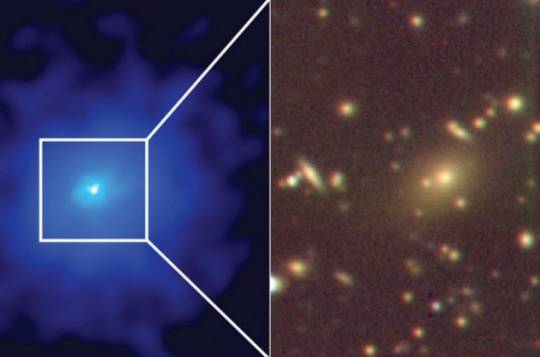
A single galaxy cluster can hold hundreds or even thousands of galaxies. These clusters are considered to be the biggest pieces in the universe. One might think it impossible for a cluster to be hidden by a single space object. However, that is exactly what one quasar did. This supermassive black hole was tagged as PKS1353-341 and filed away as a lone entity in its region. In 2018, MIT scientists released a photo that showed the truth. The quasar sat at the center of a galaxy cluster. The black hole was exceptionally bright, and the radiance blotted out the light of millions of stars. No other galaxy has been hidden in this way. Located about 2.4 billion light-years from Earth, the quasar’s glare likely comes from a feeding frenzy. It is believed that PKS1353-341 consumes matter at an exponential rate, releasing enough energy to burn 46 billion times brighter than Earth’s Sun. Astronomers expect it to settle down in a million years or so.
5 Binary Systems
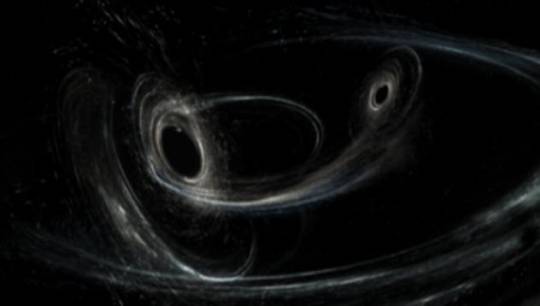
Another unsolved aspect of black holes is that some appear as binary, or a pair in orbit around each other. This is dangerous living. So far, three cases of black holes colliding have been documented. Two were detected in 2015 and another in 2017. Amazingly, the latter’s signal consisted of gravitational ripples from a split-second smash three billion light-years away. Neither was destroyed but instead blended into a single black hole bigger than both of its two parents. This third merger was an important one for researchers. It provided another case of a rarely seen event and also helped to solidify a new observational science regarding gravitational waves. As to how binary black holes form, researchers consider two likely scenarios. Binary stars might die and leave behind the black holes. Alternatively, they formed separately and only later drifted closer to each other and became gravitationally bound.
4 Earth-Destroying Bubble
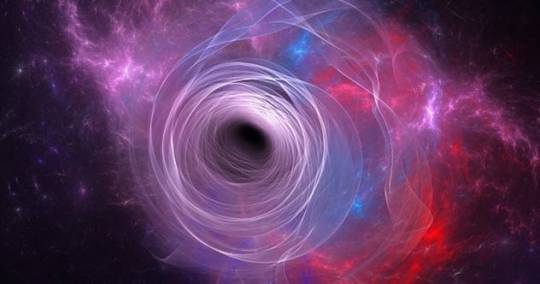
In 2018, physicists added another way that black holes could theoretically obliterate Earth. Recently, the scientific world celebrated the discovery of gravitational waves—a phenomenon that stretches and compresses the fabric of reality. It sounds crazy enough, but the fact is that this is also a deadly force. The new theory looked at gravitational waves moving away from a high-energy collision event as a bubble. Spreading at the speed of light, it grows larger until some points resemble flat surfaces. If two bubbles collide at a flat-surface point, the worst-case scenario suggests that space-time would likely concentrate into a black hole. If this happened near Earth, it would be catastrophic. On the plus side, if it could be called that, nobody would die a strange death down the new black hole. The gravitational waves behind its formation would fatally stretch the planet to shreds first.
3 A Banished Black Hole

Scientists have always entertained the possibility that galaxies can eject their central black holes. However, no proof of this was ever found. Then, in 2017, a galaxy called 3C186 delivered a surprise. The result of two galaxies that merged at some point in the past, 3C186 should have appeared a little messy. Instead, it was well-defined and settled. The real surprise came when researchers searched the center for the usual supermassive black hole. Nothing was there. When they found it, the black hole was over 35,000 light-years from the center. As the two star clusters collided, so did their supermassive centers. This created a monster-sized black hole. The merger likely released gravitational waves powerful enough to eject the new hole. This was no small feat. To swat the black hole aside, an energy burst equal to 100 million supernovas was needed. Whatever happened, it provided the first glimpse at forces stronger than the dominance that black holes famously display over their territories. The unique behemoth continues to reel at breakneck speed. At its current pace, the black hole can leave the galaxy for open space in about 20 million years.
2 Possibility Of Time Reversal

A black hole is created when a huge star dies and collapses in on itself. At that moment, the event shoots out streams of gamma rays. The latter is the brightest force known in nature and is still not fully understood. In 2018, the mysterious signals revealed another strange skill—they appear to reverse time. Scientists discovered this when they studied the six strongest gamma-ray bursts recorded by NASA. Each event shot out a light wave with a signature pulse sequence. Oddly, the gamma ray was then repeated with its pulse sequence reversed. This may not sound weird, but nothing is normal around a black hole. For some physicists, the backward signal is a sign of time reversal. The cause is a complete mystery. Alternative suggestions look at the more material level of matter. The gamma ray could be moving through clumps of matter, which creates the signature. To reverse it, the beam could be hitting an unknown mirrorlike surface somewhere or behaving according to an undiscovered physics law.
1 Ghosts From Dead Universes

In 2018, a controversial physicist claimed something spectacular. Roger Penrose had already raised the wrong eyebrow among neuroscientists when he claimed that human consciousness was the result of quantum computing. Now, Penrose believes that ours is the latest of a series of universes. More to the point—that black holes from dead universes can be detected in the one that exists today. This theory hinges on something called Hawking radiation. Stephen Hawking famously suggested that black holes eventually disintegrate after losing enough particles. Called gravitons and photons, they are massless and do not experience conventional speed and time As a result, when a universe dies and a new one forms, like-minded scientists argue that these particles survive. The part detected is Hawking radiation, or the energy that black holes spent dissolving themselves in the long-gone cosmos. Experiments returned positive results, which strengthened Penrose and his supporters’ call to modify the big bang theory. If they are correct, instead of a bang that formed only the one cosmos, universes follow on each other like rising bubbles. Read the full article
0 notes
Photo

Seeing double
In this new Hubble image two objects are clearly visible, shining brightly. When they were first discovered in 1979, they were thought to be separate objects — however, astronomers soon realised that these twins are a little too identical! They are close together, lie at the same distance from us, and have surprisingly similar properties. The reason they are so similar is not some bizarre coincidence; they are in fact the same object.
These cosmic doppelgangers make up a double quasar known as QSO 0957+561, also known as the “Twin Quasar”, which lies just under 14 billion light-years from Earth. Quasars are the intensely powerful centres of distant galaxies. So, why are we seeing this quasar twice?
Some 4 billion light-years from Earth — and directly in our line of sight — is the huge galaxy YGKOW G1. This galaxy was the first ever observed gravitational lens, an object with a mass so great that it can bend the light from objects lying behind it. This phenomenon not only allows us to see objects that would otherwise be too remote, in cases like this it also allows us to see them twice over.
Along with the cluster of galaxies in which it resides, YGKOW G1 exerts an enormous gravitational force. This doesn’t just affect the galaxy’s shape, the stars that it forms, and the objects around it — it affects the very space it sits in, warping and bending the environment and producing bizarre effects, such as this quasar double image.
This observation of gravitational lensing, the first of its kind, meant more than just the discovery of an impressive optical illusion allowing telescopes like Hubble to effectively see behind an intervening galaxy. It was evidence for Einstein’s theory of general relativity. This theory had identified gravitational lensing as one of its only observable effects, but until this observation no such lensing had been observed since the idea was first mooted in 1936.
Links:
ESA/Hubble release: Gravitational telescope creates space invader mirage
ESA/Hubble release: Lenses galore — Hubble finds large sample of very distant galaxies
ESA/Hubble release: Hubble finds double Einstein ring
https://www.spacetelescope.org/images/potw
12 notes
·
View notes